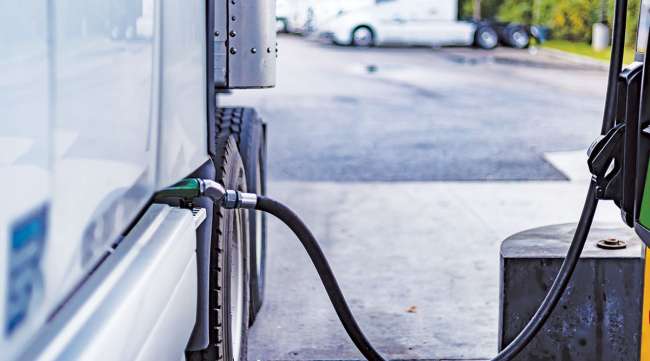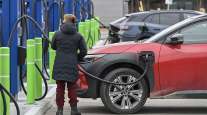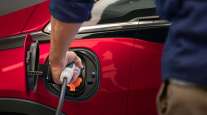Staff Reporter
Rural States, Groups Tell EPA of Emissions Proposal Concerns

[Stay on top of transportation news: Get TTNews in your inbox.]
State transportation planners, rural farmers and electric utilities are joining a chorus of stakeholders expressing concern about the potential consumer and business costs associated with a federal proposal aimed at expanding use of electric vehicles and curtailing the prevalence of internal combustion engines.
The departments of transportation for Idaho, Montana, North Dakota, South Dakota and Wyoming in a letter to Environmental Protection Agency Administrator Michael Regan said the agency’s proposed Emissions Standards for Model Years 2027 and Later Light-Duty and Medium-Duty Vehicles rule, which aims to propel a shift from diesel- and gasoline-powered vehicles to EVs, would drastically affect revenue flowing into the Highway Trust Fund — which is derived from federal taxes on gas and diesel. They note that EVs contribute nothing to the fund, yet still exacerbate wear and tear on roads. The loss of this revenue for road maintenance, they argue, would negatively affect access to essential services, such as schools, employment, food, health services and more.
The states further noted that EV usage is much less common in their states compared with others. “EVs are not well-suited for all of our nation’s climates, especially in states that are rural, are at high altitude, or both,” their letter said. “In such areas, long-distance travel in often extreme temperature ranges significantly impact EV range.”

Regan
The long distances and sparse revenue that define operations for some rural electric utilities were the crux of concerns expressed by the National Rural Electric Cooperative Association, which in its comments expressed “significant concern that EPA has failed to adequately account for the costs associated with serving the new load that will be created via light- and medium-duty vehicles.”
“On average, electric cooperatives serve eight customers per mile of line and collect annual revenue of approximately $19,000 per mile, while the other utility sectors average 32 customers and $79,000 in annual revenue per mile,” said NRECA Regulatory Affairs Director Stephanie Crawford in a letter to EPA.
The group represents 900 local electric cooperatives and rural electric utilities in agricultural regions and isolated farming communities. About 42 million Americans across 56% of the country get power from electric cooperatives, including 92% of the nation’s persistent poverty counties and low-population areas in rural and disadvantaged areas.
Crawford’s letter outlined supply chain challenges and transmission system upgrades required for these utilities, which would result in higher customer costs: $4,000 per household to add electrical breakers for EV chargers, new transformer fees that range from $25,000 to $40,000 and power line extension costs of between $50,000 and $75,000.
“Electric cooperatives are waiting a year, on average, to receive distribution transformers,” she said. “Additionally, lead times for large power transformers have grown to more than three years, and orders for electrical conduits have been delayed fivefold to 20 weeks with costs ballooning by 200% year-over-year. As a result, new projects are being deferred or canceled, and electric cooperatives are concerned about their ability to respond to major storms due to depleted stockpiles.”

How effective have third-party services proved to be for fleets? Let's find out with Michael Precia of Fleetworthy Solutions and Dan Rutherford with Summit Virtual CFO by Anders. Tune in above or by going to RoadSigns.ttnews.com.
Costs and availability of charging infrastructure were cited as concerns from the Missouri Farm Bureau, which represents 147,000 families. In a letter from President Garrett Hawkins, the group stressed that EV adoption would increase average upfront per-vehicle costs to meet the proposed standards by around $1,200 in model year 2032.
Hawkins also expressed concerns that not enough public charging stations would be available in rural areas.
The Michigan Corn Growers Association submitted 30 form letters signed by farmers voicing concern about an estimated loss of demand for about 1 billion bushels of corn used for biofuels that “will hurt family farms all over the country.” The group also echoed sentiment that EV infrastructure “does not yet exist in rural America” and voiced doubt that EV power can handle the workloads placed on their farm vehicles.
Representing ranchers, farmers and rural communities, the farmers unions from both North Dakota and Minnesota sent letters urging EPA to factor in more biofuels to lower emissions rather than heavily emphasizing EV usage.

Wertish
“We understand the realities of climate change because we are already among those on the front lines, experiencing early effects in the form of unpredictable weather, increased pressure from pests and our states’ ongoing drought,” wrote Gary Wertish, president of the Minnesota Farmers Union. “We see biofuels — and moving toward high-octane mid-level ethanol blends — as a near-term, cost-effective step we can take to lower the carbon intensity of our transportation fleet.”
Mark Watne, president of the North Dakota Farmers Union, said biofuels have an important role in supporting family farms and rural communities while also enabling the EPA to help reach its emission goals. “We are concerned that EPA’s proposal is biased in favor of BEVs and against renewable fuels,” he said.
Want more news? Listen to today's daily briefing below or go here for more info:




